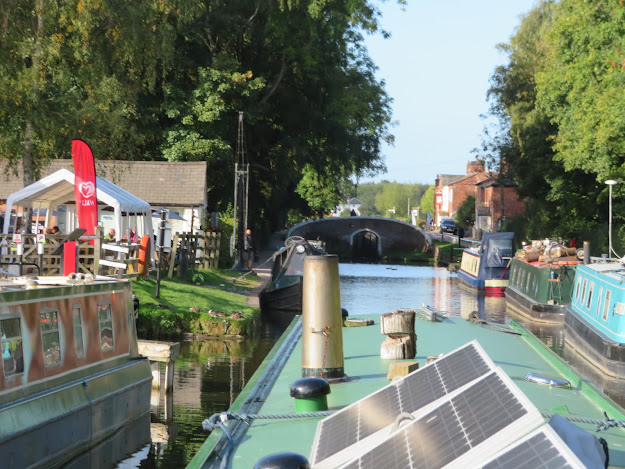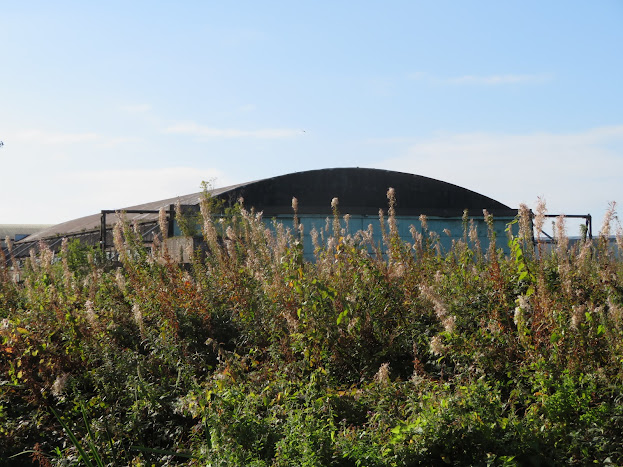We had chips for tea from the shop in the village for a change and a good kip before heading off up the Birmingham and Fazeley Canal the next day.
The Junction House has been saved and revitalised over the last couple of years and gives the junction a bit of class.
Before we leave Fazeley behind a little about the wharf. The canal was completed in 1789 but in 1795 there were big floods that caused a lot of damage to the infrastructure such as the bridges at Fazeley, Hopwas and the Thame aqueduct just outside Fazeley. I think the wharf was established from the opening of the canal and as can be seen was of a good size.
Fazeley Wharf from the OS map of 1921. You can see the length of it by the number of mooring posts. I'm not sure the crane there at the moment is the same one.
It seems that until around 1841 the wharf was run by Thomas Bache and Co who were major canal carriers of their day. They started in Manchester, I think in the 1790's. They seemed to cover the then system running fly boats from Liverpool and Manchester Coventry and London with many wharves along the routes. I read that in 1827 they had 25 boats working. By 1838 they were also using shipping by sea to move freight so a fully integrated transport system. In 1839 it was two boatmen employed by Cache and Co that gave evidence against the murderers of Christine Collins at the Rugeley. By that year they were running fly boats and using the railways system. They claimed that the canal charges were the lowest there was. In December that year there were changes as the partnership of the business between Thomas Bache, Thomas Morris and John Herbert was dissolved and Bache was out. The new company was styled Morris Herbert and Co. By May 1841 the new company gave notice that they were discontinuing the canal carrying business and it seems that by then they were based in Coventry.
The footbridge and swing bridge are a well photographed feature of the start of the canal. We had stopped at the Fazeley Marina to get some coal to guard against evening cold. It was interesting to see that the marina was built in what was a reservoir to supply a mill. It must have been constructed to provide a supply when the canal was built and cut off the supply.
Drayton Brick Bridge seems miles away from anywhere, and a little further on the Kingsbury Water Park that is made up of old gravel pits mean that there are plenty of walkers and bird watchers. There is a nice walk on the west side to Middleton Hall
The Birmingham Canal Cottages at the first of the Curdworth Locks give it a lovely setting complete with a little swing bridge above the lock.
Helen brings her in under Cheatle's Farm Bridge and into the third lock of the flight.
Just above the lock is the Dog and Doublet pub and a convenient spot to stop halfway up the flight.
The Dog and Doublet pub is an old establishment, often called the Dog and Jacket until around the 1930's It is said to have been built by the first landlord a bloke called Clarrson in 1786. By 1899 Reuben Henry Stevenson had taken over as landlord. He had been a small farmer at the next door Marston Farm. He had been born in Harleston Staffordshire, where his father had been a miller and he had learned the trade from him. Reuben was well thought of in the area and at the pub set up the Pig Club and the Sick and Dividend Clubs. These were all self help groups where everybody chipped in for mutual benefit and also held the meetings at the pub. He also sat on the Tamworth Board of Guardians, Tamworth Sanitary Authority, Tamworth Rural district Council and was on the Kingsbury School Board
Frederick Smith Ltd., brewers bought the pub in 1899.
This is the trade mark of the Fred Smith Brewery. His father had been a cooper and brewer and when he died Fred worked for who the brewery was sold to for a couple of years before setting up on his own in Lichfield Road, Aston, in 1880. The business expanded and he built a new brewery calling it the Model Brewery. The business continued to do well. Fred was knighted by King George V for services to the community in Aston and Birmingham. The business was sold to William Butlers brewers.
F. Smith Ltd also owned the beerhouse in the village called the Beehive that had been licenced in 1869. The brewery's plan was to move Reuben to the Beehive, knock down the Dog and Doublet and build a new pub nearby. The licencing authority was not keen. First they were trying to reduce the number of outlets but they realised that the the new pub would be even bigger than the two others put together. It took several years for a deal to be done. In then end it seems that the Dog and doublet was extended and the Beehive survived until into the 1930's. Reuben Stevenson was remained until 1914 when the licence was transferred. Reuben died in 1923 aged 72 following an accident when his horse slipped when returning back from Tamworth and he and his wife were thrown out of the trap. He died a few weeks later of complications. Another long term families at the pub was the Greatbatch's. (Greatbach) William and May took over the licence in 1920 and the family were still at the pub in 1963.
We didn't stop though, continuing up the flight to the top. Just before the top lock, that is new having to be moved for the construction of the M42 link road is this tow path bridge. This is the site of Dunton Wharf and basin.
I assume a wharf was set up here when the canal opened but I'm not sure when the basin was dug. By 1834 the Daw End Lime Company was using the place. As this map extract from 1886 shows there were lime kilns on site. At this time the company was run by Thomas Cooper and George Strongitharm and they distributed lime from Walsall, Dunton, Bodymoor Heath, Catshill, Ogley, Essington and Rugeley. The limemaster added coal to their offerings but in 1846 the business was run by William Cooper and George Strongitharm with places at Minworth, Dunton and Bodymoor Heath. It looks like they left in 1871 and J.M. Dormor took it on, adding salt, bricks, tiles and drain pipes to the list sold. Later building supplies generally were also on offer. After that several different people made their living from the wharf and gadually reducing the products to just coal. In 1889 Lordon Norton owned the site
We carried on a little past the top lock to escape the traffic noise from the motorway. Once moored up, and with a dry evening and not too cold I set too polishing the port side of the boat. It took longer than anticipated as I was engaged in conversation by the passers by. I was also eaten alive by bugs and driven inside by the cold. The coal from Fazeley came in useful that night as we lit the fire to warm me up. This area will change if and when the HS2 gets built as it comes through this section.






















































